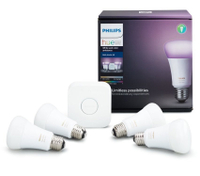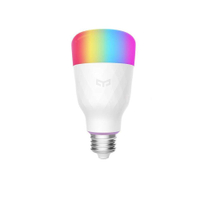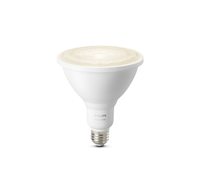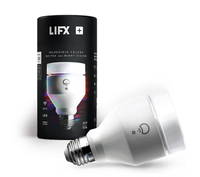But, of these new options, which would be best for your home? We’ve created this light bulb guide to help answer this very question. Here, we will talk you through the differences including the advantages and disadvantages of each bulb. By the end, you will be confident enough to pick the best light bulb, or the best smart light bulb, for your home.
LED vs. incandescent bulbs
The traditional incandescent light bulb measures its brightness by wattage — meaning the greater the wattage, the brighter the bulb. However, this concept couldn’t be converted to LED or other modern bulbs as they required less wattage to produce brighter results. As a consequence, we started measuring in lumens, which equates to the brightness itself, instead of energy consumption. The below table demonstrates the difference between an incandescent light bulb and an LED bulb in terms of the energy required to produce the same brightness (lumens).
CFL and halogen bulbs
Other replacement lightbulb choices consume more power than LED bulbs and have shorter rated-lifespans, but cost much less upfront. A 60-watt–equivalent CFL bulb from Philips, for example, consumes 13 watts and has a rated lifetime of 12,000 hours (or about 11 years) when lit for three hours a day, but retails for only $1.50-$2.50. While technically a form of incandescent lighting, halogen bulbs are more efficient than traditional bulbs. Many companies sell “eco-Incandescent” bulbs which look like traditional lightbulbs, but use halogen elements. But they are still no match for LEDs. A 60-watt–equivalent halogen bulb from Philips consumes 43 watts and has a rated lifetime of 0.9 years. It also retails for under $5.00.
Other light bulb alternatives
EISA has stopped the manufacturing of candle-and globe-shaped 60-watt incandescent bulbs (the types used in chandeliers and bathroom vanity light fixtures). However, the law doesn’t affect 40-watt versions of those bulbs, nor three-way (50 to 100 to 150-watt) incandescent A19 bulbs. So, those will continue to be an option for you, as well, in fixtures that will accommodate them.
LED light bulb lifespan and cost
Traditional bulbs for table and floor lamps are known by their lighting industry style name “A19,“while floodlight bulbs made for track lights and in-ceiling fixtures are dubbed “BR30.” Your best long-term alternative to either style is extremely energy-efficient LED technology. The LED equivalent of a 60-watt A19 bulb consumes only between 9 and 12 watts, and provides about the same light output, measured in lumens. A 40-watt equivalent LED bulb consumes only 6 to 8.5 watts. And a 65-watt BR30 (floodlight) replacement LED bulb consumes only 10 to 13 watts. An LED bulb’s lifespan, estimated based on three hours of use per day, is at least a decade, manufacturers say. Under the same conditions, an old-fashioned lightbulb may work for only about a year before burning out. GE’s equivalent LED bulb has a rated lifetime of 15,000 hours or 13.7 years. Philips’ equivalent LED bulb has a rated lifetime of 10,000 hours or 9.13 years. LED bulbs will continue to light up even after their rated lifetimes expire; however, brightness may drop or the color cast of the light may change.
LED light bulb color temperature meaning
GE, Philips, Sylvania, Cree and other brands (including IKEA) all offer LED bulbs that output the most popular “soft white” light, at retailers including Home Depot, Target and Walmart. In addition, GE ‘s Reveal lineup of color-enhancing lightbulbs (a coating filters out yellow tones to enhance colors lit by the bulb) with LED replacements equivalent to 40-watt and 60-watt A19 bulbs and to a 65-watt BR30 bulb. When they first came out, LED bulbs emitted a bluish light that many found harsh compared to the “warmer” light cast by traditional bulbs. However, LED makers now offer LED bulbs that emit different color temperatures, measured in Kelvin. Here are a few that you’ll most likely find at a home improvement store: 2700K: These bulbs will be labeled “soft white,” and will cast a gentle warm glow that’s good for the bedroom, as well as table and floor lamps. 3000K: “Bright White” bulbs have a more neutral glow, being neither warm nor cool. 5000K: Lights that are 5000K and higher will typically have a “daylight” label, and edge towards the bluer part of the spectrum. However, they will best approximate actual sunlight.
Smart LED bulbs
A new subset of LED bulbs are so-called “Smart Bulbs,” in that they can be controlled by your smartphone, and often have other features built in, such as the ability to work with a wide range of best smart home devices. However, these also cost more than other LEDs. MORE: Every Smart Light That Works with Alexa
Best smart light starter kits
Companies whose bulbs require a bridge or hub to connect to your Wi-Fi network (which includes Philips, Sengled, and IKEA) often sell starter kits, which include several bulbs plus the bridge.
Best Wi-Fi smart bulbs
Bulbs with built-in Wi-Fi can connect directly to your router, so there’s no need to install a bridge first. However, on a per-bulb basis, Wi-Fi bulbs tend to be more expensive and larger than their counterparts.
Best miscellaneous bulbs
Best bulbs with extra features
In addition to providing light, there are a number of smart bulbs that have added features, such as speakers, Wi-Fi extenders, and infrared lights.
Best nontraditional lights
Because LEDs are so small, they can be used in a variety of shapes and installations, from long strips of light to even more exotic designs.




